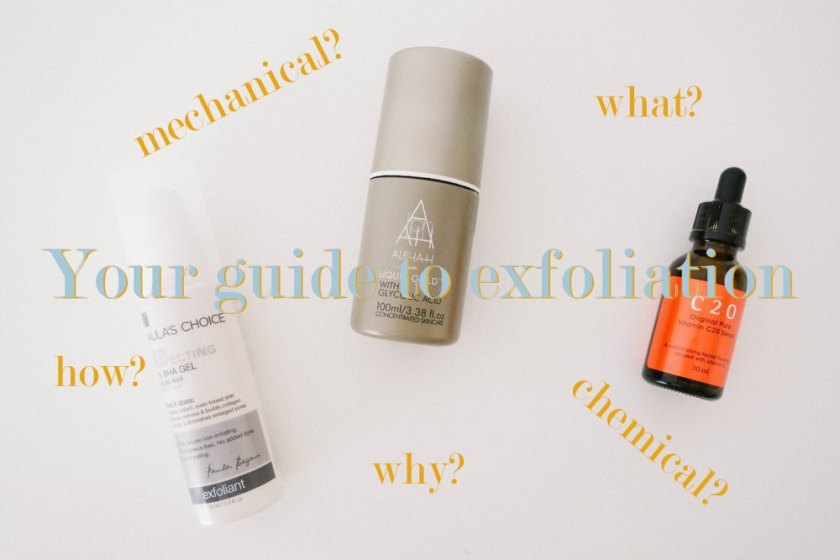
To exfoliate or not exfoliate? That is not even a question in need of consideration. The answer is crystal clear: Yes, please! And if possible, at least twice a week.
What is exfoliation and why do we need it?
Our skin continually renews itself as it casts off dead skin cells and replaces them with new ones. As we grow older, however, our body’s natural cell turnover process increasingly slows down. The results are visibly aging skin and a lackluster complexion.
Exfoliation can reverse these effects. It sloughs off the top layer of the skin so that cells are replenished faster. This brings out remarkably softer and younger looking skin. More importantly, however, exfoliation clears the skin from dead skin cells, residual dirt, oil and other debris. Thus it unblocks pores and lightens dullness for a clearer and more radiant complexion. In short, exfoliation is recommended for anyone, whether young or old.
Skeptics claim that regular exfoliation thins out the skin in the long term, but this is an urban myth. Unless you’re using really high concentrations of acid peels or work with abrasive materials, no such thing happens. On the contrary, dermatologists and skin care experts alike unanimously agree that gentle exfoliation is beneficial for the skin and actually increases firmness.
So now that we have established what exfoliation is good for, let’s look at the two different kinds of exfoliation available for at home use.
Mechanical/physical peelings
Dirt and debris can be removed through friction and mechanical motion. So generally speaking, any kind of cleansing is exfoliating. For improved results, however, try scrub cleansers, washcloths, or brushes.
The rule of thumb for physical peelings is to not overdo it. If too abrasive or harsh, mechanical peelings can damage the skin by tearing microscopically small scratches into the skin’s surface. These in turn can attract bacteria, and eventually inflame.
One more thing: Scrubs contain micro-beads, which, to cut costs, are often made from plastic. As such, they end up in our lakes and oceans, damaging water supplies, marine life and the ecological balance of the planet. In short, they pose huge environmental problems.
Personally, I use scrubs only for the body, in which case I like to make them myself by mixing coconut oil with unrefined brown sugar. For the face, I use the Shiseido Cleansing Massage Brush regularly, and love it.
- The Clarisonic Mia 2® Facial Sonic Cleansing 2-Speed Brush via Space NK UK
is another popular, albeit more expensive option.
- For further infos on washcloths, Into the Gloss posted a list of the best washcloths for the face.
Chemical peelings
As the name suggests, these peelings work chemically. Exfoliation agents like fruit enzymes, good for sensitive skin types, or acids, for all other skin types, can be found in masks and leave-on products. In cleansers they’re mostly ineffective.
As mentioned above, acids can potentially leave burns if administered in high doses. But the concentrations available in over the counter products are generally safe.
All chemical exfoliants work by dissolving the substance that holds together skin cells, thereby removing dead skin cells and other trapped dirt.
BHA can also penetrate through clogged pores clearing them out from within due to its oil-solubility. For this, concentrations from 1 – 2 % are enough.
AHAs such as glycolic acid, lactic acid, or mandelic acid, on the other hand, supposedly diminish lines, sun damage, and hyper-pigmentation. However, in concentrations from 4 – 10 % usually found in at home use products, these additional effects will be minor. Magic may or may not happen at 30 – 70 % concentrations, which need to be administered by a dermatologist, however, and over a span of several sessions.
Note that AHAs are often found in formulas alongside potential irritants, so they’re not entirely unproblematic in at home products either. Plus, they increase the skin’s photosensitivity, so sunscreen during the day is a must when using AHA or BHA! If you find a product that works for you, however, acid peels are gold.
Myself, I love and use the Alpha-H Liquid Gold two nights a week. For more AHA products,
- the Peter Thomas Roth Glycolic Acid 10% Moisturizer or
- the Paula’s Choice Resist Daily Smoothing Treatment with 5% Alpha Hydroxy Acid
should yield great results, too.
As for BHAs, I currently use the Paula’s Choice Skin Perfecting 2% BHA Gel Exfoliant.
- The philosophy clear days ahead oil-free salicylic acid acne treatment & moisturizer and
- the Paula’s Choice Clear Extra Strength Anti-Redness Exfoliating Solution with 2% Salicylic Acid
both seem very good also.
Conclusion
Personally, I love acid peelings myself. They’re very effective yet gentle, and come with a slew of additional benefits for the skin. I started out with AHAs, but now have also added BHAs to my daily skin care routine since.
At the same time, massaging the face with a soft brush and gentle cleanser is a treat in itself, too, though. Combine it with a manual lymphatic drainage face massage, and you’re set for a smooth and glowing complexion!
What is your preferred method of exfoliation? And do you have any more questions on the topic?

